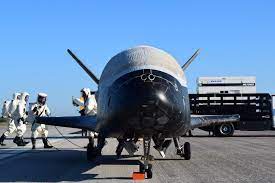In August, a Chinese rocket carried a projectile into space. That projectile, reported by US intelligence agencies as a missile and by China as a reusable space vehicle, fell into an orbit, circled the globe, and then glided into a spot about 24 miles away from its original target. The launch represents a demonstration of a new capability for China, the revitalization of an old technology, and a complicated way to bypass existing missile defenses.
Every missile has a path it follows. For intercontinental ballistic missiles (ICBMs), that path is a high arc over the North Pole, hundreds of miles up and then down again; they don’t go into orbit. Cruise missiles fly much closer to the ground. Atmospheric hypersonic missiles, like the kind DARPA tested in September, stay within the atmosphere while moving at great speed.
For this test of China’s new weapon, its reported likeliest trajectory was into orbit, and then out of orbit later in its flight, never arcing as high as an ICBM would. Orbit isn’t so much a fixed space as it is a kind of fixed relationship with gravity. “Orbit is when you are traveling fast enough at an altitude that you are falling, but you are falling so fast that you are falling over the horizon and keep going in a circle,” said Jeffrey Lewis, professor at the Middlebury Institute of International Studies at Monterey, in the most recent episode of the Arms Control Wonk podcast. “You enter orbit, and if you want to leave orbit, you have to expend energy so that you start falling back down again.”
China already has ICBMs, bombers, and a pair of submarines to deliver its modest arsenal of nuclear weapons. What this new test demonstrated was another way to put a nuclear weapon near a target, though even by the horseshoes and hand grenades rules of nuclear detonations, 24 miles off target is a huge miss.
In short: the launch was a demonstration and test of a possible weapon system, pairing a rocket to get the weapon to space and a payload designed to return to Earth.
It is possible that, in describing it as a missile and a reusable space vehicle, the United States and China are referring to essentially the same thing. US intelligence described it in the original report, by the Financial Times, as a “nuclear-capable hypersonic missile,” indicating a trajectory, speed, and end state for the path. A reusable vehicle could also demonstrate the same flight trajectory and weapons capacity.
Interestingly, as Lewis said in the same podcast, the Space Shuttle itself was a kind of reusable hypersonic glide vehicle. Decades before the Space Shuttle, the Air Force and NASA explored hypersonic reentry with the Dyna-Soar orbital glider, and Space Force’s modern X-37B robot space plane can return to Earth in a similar way.
To understand why China might want to develop such a system, it helps to go back to the past, when the Soviet Union pioneered such a trajectory for nuclear weapons. Called “FOBS” for “fractional orbital bombardment system,” it was a weapon that enters and then leaves orbit. (Putting a weapon somewhat, or fractionally, into orbit, if only for the duration of a flight, was spun in part as a way to avoid the Outer Space Treaty’s prohibition on weapons in orbit.)
Going through this hurdle only makes sense if there’s a reason a FOBS is better than an ICBM. A FOBS allows a country to send a nuclear weapon the long way around over the South Pole, instead of the much shorter path of up and down again over the Northern Hemisphere, which is the route that an ICBM would typically take. It’s a longer flight path, but it’s also a flight path through a slice of sky with fewer early warning sensors. The launch itself would still be detected, as infrared sensors in space can see when a rocket blasts off, but the rest of the apparatus of tracking launched objects suffers if the missile moves away.
A FOBS avoids some tracking, because it is low enough to the planet that sensors designed to see rockets arcing high into space in the Northern Hemisphere have their view blocked. When the FOBS returns north, to hit its target, it also travels at an angle outside the path of dedicated and fixed missile defenses. Missile defense is a hard problem in the best of times, for a host of reasons. Intercepting a bullet with a bullet means tracking the incoming weapon, calculating its velocity accurately, and then hoping that the interceptor accurately finds the warhead instead of a decoy or a distraction.
If the nuclear attack is coming from a FOBS, it will likely bypass most tracking sensors, remerging in range of missile defenses with hardly any time to respond. The USSR developed FOBS as a way to get around an earlier era of US missile defenses.
Source : https://www.popsci.com/technology/china-hypersonic-space-weapon-test/









